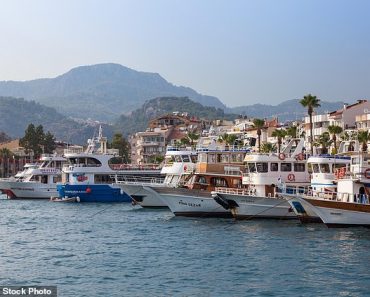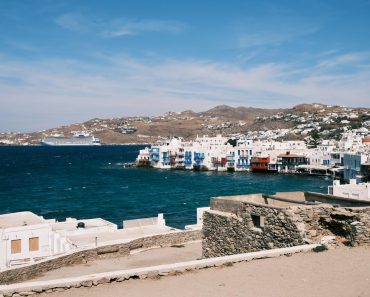At first glance Syros looks like many other Cyclades islands, its sun-baked hills studded with whitewashed villages. But approaching the shore by ferry, the bustling little capital, Ermoupoli, looks more as if it has been transplanted from Italy. Pastel-coloured neoclassical buildings overlook the water, marble streets reflect the sunshine and the whole scene is crowned by two hilltop churches, one Orthodox, the other Catholic.
This is an island with a rich Venetian history. It measures just 32 square miles — a sliver smaller than neighbouring Mykonos, a 25-minute ferry ride away — but it flourished in the 19th century, becoming the most important port in Greece. It’s still the administrative capital of the Cyclades, and it never really embraced tourism in the same way as its far more famous neighbour.
When I joined a smattering of fellow holidaymakers dragging their cases off the Athens ferry, the best way to arrive here, it was clear that I had walked into a living town rather than a white-and-blue Instagram backdrop. People sipped iced coffees at waterfront cafés; delivery drivers zipped by on scooters, loads precariously balanced; and, as the sun dropped, workers in overalls cycled by, returning from the neighbouring shipyard.
It was still beautiful, with streets shaded by clouds of bougainvillea. But instead of cobbles the streets were creamy marble, and instead of whitewashed homes there were grand palazzos once owned by wealthy merchants.
A pretty cobbled street in the city
ALAMY
No big resorts but plenty of boutique hotels
Syros sits at the heart of the scattered Cyclades, southeast of Greece’s Attica peninsula. On every horizon is a better-known holiday destination: Paros and Naxos to the south, Mykonos due east and the great hulk of Andros to the north.
While there are no direct international flights, you can hop to Syros by plane from Athens; it takes just 35 minutes. But for me, travelling to Greek islands demands a ferry and there is no shortage of comfortable options. It took just two hours from the port of Piraeus, and I scuttled off as staff barked and the vessel strained at its ropes, eager to set off for the next islands after just minutes in port.
• 21 of the best Greek island cruises
What awaited was quite possibly the world’s shortest taxi ride to my hotel, tucked down a narrow side street. It took all of three minutes, but meant there was no need to rattle my case through the streets in the afternoon heat.
The Castro Hotel is a converted palazzo
The five-star Castro Hotel is just one of a clutch of converted palazzos welcoming travellers, and is a delight with exposed stone walls, blond woods and a leafy courtyard. There aren’t any big resorts or brand names on this island, just boutique spots in historic buildings or scattered through the countryside.
The island has a population of just over 20,000 and there are no resort towns to speak of, just the handsome capital, countryside villages and a sprinkle of beaches where locals are just as likely as tourists to set their towels on the sand. I felt like I was visiting their island rather than taking it from them.
At my favourite waterfront coffee spot, Chalandriani (coffee from £2; Akti Papagou 16), my waitress shared her tips for favourite beaches to visit (Kini, four miles west, for sunsets; Galissas, five miles southwest, for pale-gold sands and protected waters).
Sarah Gordon enjoying the local wine
Ermoupoli had no shortage of lovely places to eat, but I walked a little closer to the shipyard one day to be rewarded by an incredible lunch of fresh calamari, stuffed tomato and aubergine and a glass of local rosé, enjoyed beneath a canopy of bougainvillea at To Mikraki (mains from £5; Folegandrou 4).
The capital itself is a proud sort of place, impeccably maintained, as if eager to show off its finery, whether it is the Apollon Theatre, Greece’s first opera house, modelled on La Scala in Milan, or the local market on Chiou Street, where ingredients are arranged outside stores like works of art.
• 15 of the best Greek islands to visit
The little Manchester of Greece
While the rest of Greece struggled against the Ottoman Empire during the Greek War of Independence from 1821 to 1829, Syros remained under the protection of the French crown. As a result its seafaring business boomed, with refugees arriving from neighbouring islands and bringing their own traditions and businesses. It created a richly diverse culture and provided the funds to build modern Ermoupoli.
The Apollon Theatre was Greece’s first opera house
ALAMY
Over the following century Syros became known as “the little Manchester of Greece” thanks to the proliferation of industry, from textiles factories to tanneries and smithies. With the decline of the port, many of these businesses had closed by the second half of the 20th century, but Syros has lost none of its swagger.
Key moments
As part of my tour Peggy Stergiou, a sprightly sexagenarian, appeared at my hotel one morning to help me explore all things food and drink. A polyglot and former French teacher who grew up on the island, she loves nothing more than showing it off and seems to know everyone.
We began at Loukoumia Sykoutris, which has been in business since 1928, making the traditional jammy sweets covered in powdered sugar that we know as Turkish delight and the Greeks call loukoumi (Mistra 8; @loukoumiasykoytri).
Loukoumi — jelly sweets in powdered sugar
ALAMY
They originally came from the island of Chios, just off the coast of Turkey, and the simple recipe was brought to Syros by refugees escaping the War of Independence in the 1820s. This small business still makes them in exactly the same way as always, in copper cauldrons, before cutting and packaging them by hand.
There must be something in the pillowy sweets, because the fifth-generation owner, Ntina Sykoutri, was still buzzing around the workshop at the age of 81, feeding us bergamot, almond and rose samples.
• Read more about Greek destinations
Before Ermoupoli, the main centre on Syros was on one of two hills just above the waterfront. Ano Syros was founded by the Venetians at the beginning of the 13th century, a tangle of whitewashed lanes that snake up to the imposing Catholic church. The streets here are so narrow and steep that mules are still used for deliveries — I encountered one named Markus with his handler as I entered the town.
The Orthodox church of St Nicholas in Ermoupolis
ALAMY
There is a flurry of restaurants and boutiques along the main lane, including Maison de Meze, where they showcase island ingredients, selling cured cheeses and cold meats, homemade chutneys and thyme-infused honey from their little store. Then they whip those ingredients into delicious meze-style dishes to serve at the rooftop restaurant, where tables are scattered under a sprawling grapevine (meze dishes from £3; maisondemeze.gr). The homemade pumpkin pie with caramelised onion and local goat’s cheese was a favourite, while the prosciutto-style louza was perfect with figs, walnuts and homemade rusks.
A vineyard that’s a labour of love
In the spirit of island hospitality, Stergiou invited me to her house in the hills inland from Ermoupoli. Built in 1857, the grand house has been handed down the generations and I was welcomed with sepia family photos on the wall, a spoon of sugar paste in water — a traditional Greek offering to guests — and a herby liqueur.
It was a perfect stop-off on our way to visit another thriving Syros business, a nearby vineyard, one of just four operating on the bone-dry island. Para…Kopois wines can be found at restaurants and bars on the island or bought direct from the vineyard (tours from £18; parakopois.com). It is a labour of love by Anezoula Nomikou and her husband, Petros Roussos, a third-generation winemaker.
Born on the island, she went to mainland Greece for her studies, but felt the pull to return home and start a business that celebrated Syros. The fiery heat and drought-like conditions of 2024 curtailed the number of bottles they produced, but they still craft six wines, including an elegant single-estate white and rosé, and a caramel-coloured sweet wine, all crafted with local grapes such as white serifiotiko and red mandilaria.
It felt as if we rolled back to Ermoupoli, and yet we still found space for a gelato made the traditional way at Django Gelato, another Syros success story that has just opened a branch in Athens (from £4; djangogelato.com).
Syros may be late to tourism, but with its warm hospitality, rich history and mouthwatering foodie scene, it is clearly making up for lost time.
Sarah Gordon was a guest of Audley Travel, which has ten nights’ B&B on a Cycladic Islands Beyond the Crowds: Athens, Syros and Tinos itinerary from £6,100pp, including flights, transfers and excursions (audleytravel.com)
Do you have a favourite Greek island? Share it in the comments













